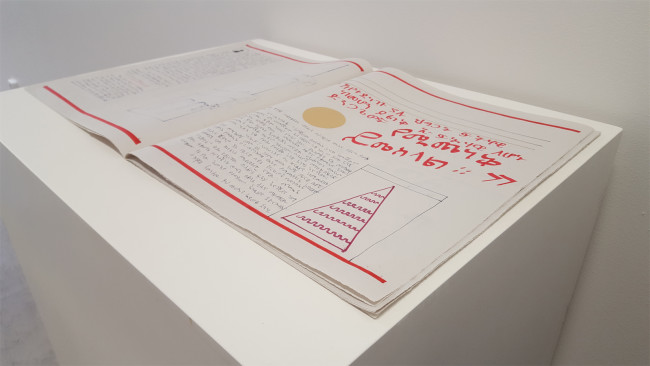28 April - 20 June 2017
/ Nows
⟶
NOWs:
Fabian Knecht
ISOLATION
Opening: April 28, 2017, 5-10 pm
at
alexander levy, Berlin
ISOLATION features photographs of conventional exhibition rooms (“white cubes”), which Knecht installed at various different locations in nature. Rather than transposing a ready-made or a representation of “reality” onto the exhibition space, Knecht brings the exhibition space into reality, isolates a segment with the help of the “white cube”: a riverbed and a base of a vanished monument in Ukraine, a frozen sea in Vladivostok, waste ground in Berlin and a section of forest in North-Rhine Westphalia. Nature in all its complexity elevated to the status of an artwork and exhibited in situ, without intervening in existing forms and forms of life. Occasionally, almost in passing, canonical artworks are referenced: from Caspar David Friedrich’s “Eismeer” (The Sea of Ice; 1823-4) through to Robert Smithson’s “Dead Tree” (1969). Consequently, ISOLATION both comments on and inverts not only the classic concept of the ready-made, but also the traditional relationship between art and nature, natura naturans and natura naturata (creating nature and created nature). “For truly art is contained in nature, and the person who succeeds in extracting it out, has it …”, writes Albrecht Dürer. And anyone who leaves it in place, surrounds and exhibits it – has it too.
The exhibition space becomes a medium, and consequently morphs from a background to a work (that is equally non-locational and location-based, and conveyed by photo is almost unreal) – before subsequently once again being made into a background: a work at the divide and fracture between space, nature and photography. The photos hang in an exhibition space. And the exhibition spaces in nature have been removed. But nature – spoiled and unspoiled – remains where it was before: beyond the frame.
The project ISOLATION was realized in cooperation with the architect Ivy Lee Fiebig. Special thanks to Markus Schütte, André Simonoff, and the Zarya Center for Contemporary Art in Vladivostok, who made the realization of the project possible.
NOWs:
Fabian Knecht
ISOLATION
Eröffnung: 28 April 2017, 17-22 h
alexander levy, Berlin
ISOLATION zeigt Fotografien von konventionellen Ausstellungsräumen (»White Cubes«), die Knecht an unterschiedlichen Orten in der Natur installiert hat. Statt ein Readymade oder eine Repräsentation der ›Wirklichkeit‹ in den Ausstellungsraum zu überführen, bringt Knecht den Ausstellungsraum in die Wirklichkeit, isoliert ein Segment mithilfe des »White Cubes«: ein Flussbett und ein Sockel eines verschwundenen Denkmals in der Ukraine, ein zugefrorenes Meer in Wladiwostok, eine Brache in Berlin und ein Waldstück in Nordrhein-Westfalen. Die Natur wird in ihrer Komplexität zum Werk erhoben und ausgestellt, in situ, ohne in vorgefundene Formen und Lebensformen einzugreifen. Mitunter werden – wie beiläufig – kanonische Kunstwerke ins Bewusstsein gerufen: von Caspar David Friedrichs »Eismeer« (1823/24) bis zu Robert Smithsons »Dead Tree« (1969). ISOLATION kommentiert – invertiert – so nicht nur das klassische Konzept des Readymades, sondern auch das traditionelle Verhältnis von Kunst und Natur, natura naturans und natura naturata (schaffender und geschaffener Natur). »Dann wahrhaftig steckt die Kunst in der Natur, wer sie heraus kann reißen, der hat sie…«, schreibt Albrecht Dürer. Wer sie an Ort und Stelle belässt, umgrenzt und zeigt – der hat sie auch.
Der Ausstellungsraum wird zum Medium und damit vom Hintergrund zum Werk (gleichermaßen ungebunden wie ortsbezogen und fotografisch vermittelt, beinahe unwirklich) – um dann vom Foto im nächsten Schritt erneut zum Hintergrund gemacht zu werden: ein Werk an der Naht- und Bruchstelle zwischen Raum, Natur und Fotografie. Die Fotos hängen im Ausstellungsraum. Die Ausstellungsräume sind abgebaut. Die Natur – berührt und unberührt – bleibt dort, wo sie war: jenseits des Rahmens.
Das Projekt ISOLATION wurde realisiert in der Zusammenarbeit mit der Architektin Ivy Lee Fiebig. Besonderen Dank gilt Markus Schütte, Andere Simonoff, und dem Zarya Center for Contemporary Art in Vladivostok, ohne deren Hilfe das Projekt nicht hätte realisiert werden können
